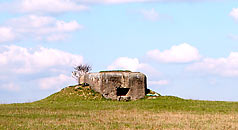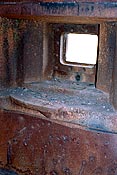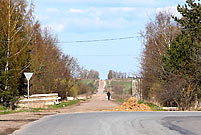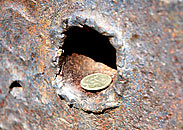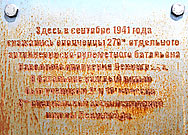History of Krasnogvardeisk Fortified Area (KrUR)
Krasnogvardeisk (Gatchina) Fortified Area (KrUR) was built in July-September 1941 for defense of close approaches to Leningrad. Its front line passed from the Gulf of Finland southern coast through Proscveschenia settlement, heights to the east of Kipjen and Ropsha, villages Bolshie Kolpany, Pizhma, Shaglino, left bank of Izhora river, Kolpino settlement and Neva river bank. Its full length was near to 100 km. Defence area depth foot from 1 up to 3 km. It's was divided to three sectors: Krasnoselsky, Central and Sluzko-Kolpinsky (the latter was transformed to separate defense area September 30, 1941).
Early in September 1941 62 concrete bunkers (artillery mainly), 273 wooden-earthen MG bunkers, 275 field artillery emplacements with crew shelters, near to 200 km anti tank obstacles (ditches and dragon's teeth) were built in the area. Rear (Pulkovskaya) defense line passed from Ligovo through Pulkovo heights to Neva river. No concrete installations were built there, exclude antitank ditches and infantry entrenchments. All construction works were made by mobilized civil peoples - woman, oldsters and youngsters from Leningrad and surround villages and towns.
The garrison of KrUR consisted of 18 APBs (artillery-MG battalion), two militia division (2-nd and 3-d DNO) and 291-st rifle division. The troops had lack of armaments and ammunitions and were untrained. In the August, the garrison was reinforced by cadets of Political NKVD College and cadets of Politruk's School. There were 479 pieces of artillery (caliber from 45 up to 130 mm) and 150 AA-guns which were intended for anti-tank defense.
The new defense system had several fundamental defects namely: wrong dispositions of some artillery and MG positions, bad fire interaction of bunkers, no mining fields, few field works - entrenchments and dig-outs, etc.
August 16, 1941, Germans 1-st and 8-th tank divisions forced the Soviet defense near to Kingisepp and begun drive to Krasnogvardeisk. August 19 they reached the advanced positions of Central sector of KrUR and August 21 engaged in hostilities on its main defense line. They had only 40 km way to Leningrad city that time.
The Germans could not break the Soviet defense and capture the Krasnogvardeisk at one blow, so they made a sweep to the east and tried to outflank KrUR from the south-east. The Vyritza and Siverskaya stations of Krasnogvardeisk-Luga railway were seized August 22. The threat of encirclement of Soviet troops in Luga Defense Area appeared, and they have begun their retreat. August 25 Germans captured station Ljubanj and severed railway connection between Leningrad and Moscow. After that they attacked the Soviet defense in Slutzko-Kolpinskij sector of KrUR (Jam-Izhora village on Moscow-Leningrad highway) but were repulsed. However, they captured the railway station Mga (to the east of Kolpino) and severed the last railway connection of Leningrad with all the country. September 8 Schlisselburg city on the Ladoga Lake shore fell and Leningrad's blockade began.
New German offensive to Krasnogvardeisk fortified Area began September 9, 1941. The main blow was made in Krasnoselskij sector near to Russko-Vysotzkoe village along the highway Narva-Krasnoe Selo. Next day the Soviet defense was broken.
Then Germans began to attack the strongholds at Dudergoff height. September 11 evening Dudergoff defensive position fell after severe battle which passed into hand-to-hand fights sometimes. September 12 Krasnoe Selo was captured, and German tanks intercepted traffic on the Krasnogvardeisk-Leningrad highway. Only the road from Krasnogvardeisk to Detskoe Selo (Pushkin) remained free. Crisp threat of encirclement for the Soviet troops in Krasnogvardeisk appeared.
September 13 Soviet troops abandoned Krasnogvardeisk by the order of supreme command and retreated to Detskoe Selo. Finally, frontline fixed along the rear line of KrUR (villages Konstantinovka, Finskoe Koirovo, Verkhnee Koirovo, Verkhnee Kuzmino, river Kuzminka).
Impressions
There are many concrete bunkers remained, some of them has traces of fierce battles. To all appearances, their garrisons were a considerable problem for German assault troops. It is fair to say the pillbox's concrete could not get its full solidity for 1-2 month from the construction date and Germans could effectively use 50-75 mm armor piercers and breached it's 1 meter thick walls.
There are many good roads and few bushes in the area, and bunkers can be easily detected and explored. Few of them closed and transformed into war memorials, but most of them are abandoned and littered.
Land forts and fortress:
Bip Castle Gatchina Ivangorod Izborsk Kexholm Kirillov Monastery Koporye Novgorod Pechorskiy Monastery Peter&Paul Fortress Porkhov Pskov Schlisselburg Staraya Ladoga Tikhvin Vyborg Hameenlinna Hamina Kastelholm Kymenlinna Lappaenranta Raseborg Castle Savonlinna Tavetti Turku Visby Fredrikstadt Fredriksten Hegra Fort Hoytorp Fort Arensburg Narva Tallinn Antipatris Caesarea Jerusalem Latrun Fort Masada
Sea forts and fortresses:
Alexander Fort Ino Fort Krasnaya Gorka Fort Kronstadt: Kotlin isl. Kronstadt: North Forts Kronstadt: South Forts Trongsund Hanko Svartholm Sveaborg Marstrand Siaro Fort Vaxholm Oscarsborg
Artillery batteries and individual guns:
Coastal Artillery Hemso Fort
Fortified areas and defensive lines:
Karelian Fortified Area (KaUR) KrUR Leningrad Mannerheim Line Nevsky Bridgehead VT Line Harparskog Line Salpa Line Gothland
Russian
S e a r c h All news

